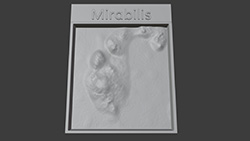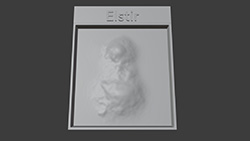Credit: X-ray: NASA/CXC/Univ. of Alabama/M. Micic et al.; Optical: International Gemini Observatory/NOIRLab/NSF/AURA
(3D Print Credit: NASA/CXC/A. Jubett, using software by Tactile Universe/N. Bonne & C. Krawczyk & Blender)
This tactile plates is a composite image of galaxy collisions as a physical relief map based on the intensity of X-ray data captured by Chandra and optical data from other telescopes.
The plate features two colliding dwarf galaxies in the late stages of merging into one larger galaxy. In this plate, a cloud represents gas and stars in the merging galaxies. The shape at its core represents a black hole being tracked by the Chandra X-ray Observatory. Directly above the cloud is another black hole, followed by a tail, curving up and to our right, caused by tidal effects from the ongoing collision. Because these two dwarf galaxies are in the final stages of merging, scientists have given the combined galaxy a single name: Mirabilis.
(3D Print Credit: NASA/CXC/A. Jubett, using software by Tactile Universe/N. Bonne & C. Krawczyk & Blender)
This tactile plates is a composite image of galaxy collisions as a physical relief map based on the intensity of X-ray data captured by Chandra and optical data from other telescopes.
This plate features two colliding dwarf galaxies in the early stages of merging. In this pair of dwarf galaxies, a cloud with a raised circle at its core sits above a larger companion with a similar shape. These clouds are the dwarf galaxies known as Vinteuil and Elstir. The raised cores represent black holes tracked by Chandra. Elstir, the larger object, near the bottom, features wispy tendrils. Several of these tendrils appear to reach up toward the smaller galaxy, Vinteuil, creating a bridge of gas and stars.
Return to: NASA's Chandra Discovers Giant Black Holes on Collision Course (February 22, 2023)












